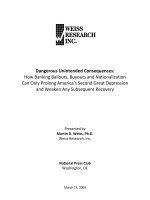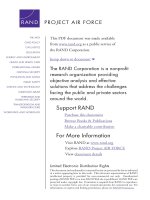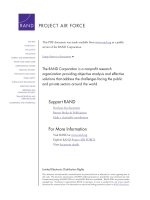America''''s Great Depression potx
Bạn đang xem bản rút gọn của tài liệu. Xem và tải ngay bản đầy đủ của tài liệu tại đây (955.61 KB, 409 trang )
America’s Great Depression
Fifth Edition
INSTITUTE
MISES
America’s Great Depression
Fifth Edition
Murray N. Rothbard
Copyright © 1963, 1972 by Murray N. Rothbard
Introduction to the Third Edition Copyright © 1975 by Murray N. Rothbard
Introduction to the Fourth Edition Copyright © 1983 by Murray N. Rothbard
Introduction to the Fifth Edition Copyright © 2000 by The Ludwig von Mises
Institute
Copyright © 2000 by The Ludwig von Mises Institute
All rights reserved. Printed in the United States of America.
No part of this book may be reproduced in any manner whatsoever without
written permission except in the case of reprints in the context of reviews. For
information write The Ludwig von Mises Institute, 518 West Magnolia Avenue,
Auburn, Alabama 36832.
ISBN No.: 0-945466-05-6
TO JOEY,
the indispensable framework
The Ludwig von Mises Institute dedicates this volume to all of its
generous donors, and in particular wishes to thank these Patrons:
Dr. Gary G. Schlarbaum
–
George N. Gallagher (In Memoriam), Mary Jacob, Hugh E. Ledbetter
–
Mark M. Adamo, Lloyd Alaback, Robert Blumen,
Philip G. Brumder, Anthony Deden (Sage Capital Management, Inc.),
Mr. and Mrs. Willard Fischer, Larry R. Gies,
Mr. and Mrs. W.R. Hogan, Jr., Mr. and Mrs. William W. Massey, Jr.,
Ellice McDonald, Jr., MBE, Rosa Hayward McDonald, MBE,
Richard McInnis, Mr. and Mrs. Roger Milliken (Milliken and Company),
James M. Rodney, Sheldon Rose, Mr. and Mrs. Edward Schoppe, Jr.,
Mr. and Mrs. Robert E. Urie, Dr. Thomas L. Wenck
–
Algernon Land Co., L.L.C., J. Terry Anderson (Anderson Chemical Company),
G. Douglas Collins, Jr., George Crispin, Lee A. Everhart, Douglas E. French,
John William Galbraith, Walker S. Green, Mr. and Mrs. Max Hocutt,
Donald L. Ifland, Joe R. Lee, Arthur L. Loeb, William R. Machgan,
Dorothea H. Marica, Bernard Morton, Daniel W. Muirhead, James O’Neill,
Charles H. Reeves (Reeves Family Foundation), Donald Mosby Rembert,
Stephen K. Salisbury, Mr. and Mrs. Allan Sawatzky, Joseph P. Schirrick,
Mr. and Mrs. Thomas W. Singleton (Nehemiah Foundation),
Robert W. Smiley, Jr. (The Benefit Capital Companies), Byron L. Stoeser,
Joseph J. Syslo, James E. Tempesta, M.D., top dog™, Alex T. Van Rensselaer,
Lawrence Van Someren, Sr., Mr. and Mrs. Quinten E. Ward,
David Westrate, Anne Williamson, Keith S. Wood
–
Robert Bero, Robert J. Birnbach, Richard Bleiberg, John Hamilton Bolstad,
Mr. and Mrs. Justin G. Bradburn, Jr., David and Elizabeth Butler,
John W. Carpenter, Dr. John P. Cochran, John Cooke, Henry V. Curll,
James V. De Santo (DTL Inc.), Chris A. Doose, Mr. and Mrs. Ted C. Earle,
Jay Elliott, Eric Englund, Dr. Larry J. Eshelman, Lawrence N. Field,
Elton B. Fox (The Fox Foundation), Capt. and Mrs. Maino des Granges,
Christopher J. Hackett, John A. Halter, John R. Harper, Frank W. Heemstra,
Douglas M. Joy, Michael G. Keller, D.O., Robert N. Kennedy,
Richard J. Kossmann, M.D., David Kramer, Steven R. Krause,
Gary R. Letsinger, Diana Lewis, J. Edward Martin, Norbert McLuckie,
Samuel Mellos, Joseph Edward Paul Melville, Robert Mish,
Dr. Dorothy Donnelley Moller, Jerry W. Moore,
Keith E. Moore, D.M.D., Reed W. Mower, Brantley I. Newsom,
Professor and Mrs. Stanley E. Porter, James A. Reichert, Thomas S. Ross,
Conrad Schneiker, Roy Schroeder, William V. Stephens,
Charles Toops, II (Mo-Ark Guide Service),
Robert H. Walker (Walker Die Casting Company),
Mr. and Mrs. Victor Zadikov, Jeannette Zummo
Introduction v
vi America’s Great Depression
Acknowledgments
W
hile the problem of 1929 has long been of interest to
myself as well as most Americans, my attention was
first specifically drawn to a study of the Great
Depression when Mr. Leonard E. Read, President of the
Foundation for Economic Education, asked me, some years ago, to
prepare a brief paper on the subject. I am very grateful to Mr. Read
for being, in this way, the sparkplug for the present book. Having
written the article, I allowed the subject to remain dormant for
several years, amid the press of other work. At that point, on the
warm encouragement of Mr. Richard C. Cornuelle, now of the
Foundation for Voluntary Welfare, I proceeded on the task of
expansion to the present work, an expansion so far-reaching as to
leave few traces of the original sketch. I owe a particular debt to
the Earhart Foundation, without whose aid this study could never
have been written.
My supreme debt is to Professor Ludwig von Mises, whose
monumental theory of business cycles I have used to explain the
causes of the otherwise mysterious 1929 depression. Of all
Professor Mises’s notable contributions to economic science, his
business cycle theory is certainly one of the most significant. It is
no exaggeration to say that any study of business cycles not based
upon his theoretical foundation is bound to be a fruitless under-
taking.
The responsibility for this work, of course, is entirely my own.
vi
Introduction vii
viii America’s Great Depression
Contents
Introduction to the Fifth Edition xi
Introduction to the Fourth Edition xvii
Introduction to the Third Edition xxv
Introduction to the Second Edition xxxi
Introduction to the First Edition xxxv
PART I: BUSINESS CYCLE THEORY
1 THE POSITIVE THEORY OF THE CYCLE 3
Business cycles and business fluctuations 4
The problem: the cluster of error 8
The explanation: boom and depression 9
Secondary features of depression: deflationary credit
contraction 14
Government depression policy: laissez-faire 19
Preventing depressions 23
Problems in the Austrian theory of the
trade cycle 29
2 KEYNESIAN CRITICISMS OF THE THEORY 37
The liquidity “trap” 39
Wage rates and unemployment 42
3 SOME ALTERNATIVE EXPLANATIONS OF
DEPRESSION: A CRITIQUE 55
General overproduction 56
Underconsumption 57
The acceleration principle 60
viii
Introduction ix
Dearth of “investment opportunities” 68
Schumpeter’s business cycle theory 72
Qualitative credit doctrines 75
Overoptimism and overpessimism 80
PART II: THE INFLATIONARY BOOM: 1921–1929
4 THE INFLATIONARY FACTORS 85
The definition of the money supply 87
Inflation of the money supply, 1921–1929 91
Generating the inflation, I: reserve requirements 95
Generating the inflation, II: total reserves 101
Treasury currency 116
Bills discounted 117
Bills bought–acceptances 126
U.S. government securities 133
5 THE DEVELOPMENT OF THE INFLATION 137
Foreign lending 137
Helping Britain 142
The crisis approaches 159
6 THEORY AND INFLATION: ECONOMISTS AND
THE LURE OF A STABLE PRICE LEVEL 169
PART III: THE GREAT DEPRESSION: 1929–1933
7 PRELUDE TO DEPRESSION: MR. HOOVER
AND LAISSEZ-FAIRE 185
The development of Hoover’s interventionism:
unemployment 188
The development of Hoover’s interventionism:
labor relations 199
8 THE DEPRESSION BEGINS:
PRESIDENT HOOVER TAKES COMMAND 209
The White House conferences 210
Inflating credit 214
Public works 216
The New Deal Farm Program 217
9 1930 239
More inflation 239
The Smoot–Hawley Tariff 241
Hoover in the second half of 1930 243
The public works agitation 250
The fiscal burdens of government 253
10 1931—“THE TRAGIC YEAR” 257
The American monetary picture 260
The fiscal burden of government 263
Public works and wage rates 264
Maintaining wage rates 267
Immigration restrictions 270
Voluntary relief 271
Hoover in the last quarter of 1931 272
The spread of collectivist ideas in the business world 277
11 THE HOOVER NEW DEAL OF 1932 285
The tax increase 286
Expenditures versus economy 288
Public works agitation 292
The RFC 296
Governmental relief 300
The inflation program 301
The inflation agitation 308
Mr. Hoover’s war on the stock market 316
The home loan bank system 317
The bankruptcy law 318
The fight against immigration 319
12 THE CLOSE OF THE HOOVER TERM 321
The attack on property rights: the final currency failure 323
Wages, hours, and employment during the depression 330
Conclusion: the lessons of Mr. Hoover’s record 336
APPENDIX: GOVERNMENT AND THE NATIONAL
PRODUCT, 1929–1932 339
INDEX 349
Contents x
TABLES
TABLE 1: Total Money Supply of the United States,
1921–1929 92
TABLE 2: Total Dollars and Total Gold Reserves 94
TABLE 3: Member Bank Demand Deposits 98
TABLE 4: Demand and Time Deposits 99
TABLE 5: Time Deposits 100
TABLE 6: Member Bank Reserves and Deposits 102
TABLE 7: Changes in Reserves and Causal Factors . . .
1921–1929 109
TABLE 8: Per Month Changes in Reserves and Causal
Factors . . . 1921–1929 110
TABLE 9: Factors Determining Bank Reserves
July–October 1929 166
TABLE I: National Product 341
TABLE II: Income Originating in Government 342
TABLE III: Private Product 342
TABLE IV: Government Expenditures 343
TABLE V: Expenditures of Government Enterprises 345
TABLE VI: Expenditures of Government and
Government Enterprises 345
TABLE VII: Receipts of Government and
Government Enterprises 346
TABLE VIII: Government and the Private Product 347
xi America’s Great Depression
xii America’s Great Depression
Introduction to
the Fifth Edition
T
he Wall Street collapse of September–October 1929 and
the Great Depression which followed it were among the
most important events of the twentieth century. They
made the Second World War possible, though not inevitable, and
by undermining confidence in the efficacy of the market and the
capitalist system, they helped to explain why the absurdly ineffi-
cient and murderous system of Soviet communism survived for so
long. Indeed, it could be argued that the ultimate emotional and
intellectual consequences of the Great Depression were not final-
ly erased from the mind of humanity until the end of the 1980s,
when the Soviet collectivist alternative to capitalism crumbled in
hopeless ruin and the entire world accepted there was no substitute
for the market.
Granted the importance of these events, then, the failure of his-
torians to explain either their magnitude or duration is one of the
great mysteries of modern historiography. The Wall Street plunge
itself was not remarkable, at any rate to begin with. The United
States economy had expanded rapidly since the last downturn in
1920, latterly with the inflationary assistance of the bankers and
the federal government. So a correction was due, indeed overdue.
The economy, in fact, ceased to expand in June, and it was
inevitable that this change in the real economy would be reflected
in the stock market.
The bull market effectively came to an end on September 3,
1929, immediately the shrewder operators returned from vacation
and looked hard at the underlying figures. Later rises were merely
xii
Introduction xiii
hiccups in a steady downward trend. On Monday October 21, for
the first time, the ticker tape could not keep pace with the news of
falls and never caught up. Margin calls had begun to go out by
telegram the Saturday before, and by the beginning of the week
speculators began to realize they might lose their savings and even
their homes. On Thursday, October 24, shares dropped vertically
with no one buying, and speculators were sold out as they failed to
respond to margin calls. Then came Black Tuesday, October 29,
and the first selling of sound stocks to raise desperately needed liq-
uidity.
So far all was explicable and might easily have been predicted.
This particular stock market corrective was bound to be severe
because of the unprecedented amount of speculation which Wall
Street rules then permitted. In 1929 1,548,707 customers had
accounts with America’s 29 stock exchanges. In a population of 120
million, nearly 30 million families had an active association with
the market, and a million investors could be called speculators.
Moreover, of these nearly two-thirds, or 600,000, were trading on
margin; that is, on funds they either did not possess or could not
easily produce.
The danger of this growth in margin trading was compounded
by the mushrooming of investment trusts which marked the last
phase of the bull market. Traditionally, stocks were valued at about
ten times earnings. With high margin trading, earnings on shares,
only one or two percent, were far less than the eight to ten percent
interest on loans used to buy them. This meant that any profits
were in capital gains alone. Thus, Radio Corporation of America,
which had never paid a dividend at all, went from 85 to 410 points
in 1928. By 1929, some stocks were selling at 50 times earnings. A
market boom based entirely on capital gains is merely a form of
pyramid selling. By the end of 1928 the new investment trusts were
coming onto the market at the rate of one a day, and virtually all
were archetype inverted pyramids. They had “high leverage”—a
new term in 1929—through their own supposedly shrewd invest-
ments, and secured phenomenal stock exchange growth on the
basis of a very small plinth of real growth. United Founders
Corporation, for instance, had been created by a bankruptcy with
Introduction to the Fifth Edition xiv
an investment of $500, and by 1929 its nominal resources, which
determined its share price, were listed as $686,165,000. Another
investment trust had a market value of over a billion dollars, but its
chief asset was an electric company which in 1921 had been worth
only $6 million. These crazy trusts, whose assets were almost
entirely dubious paper, gave the boom an additional superstructure
of pure speculation, and once the market broke, the “high lever-
age” worked in reverse.
Hence, awakening from the pipe dream was bound to be painful,
and it is not surprising that by the end of the day on October 24,
eleven men well-known on Wall Street had committed suicide.
The immediate panic subsided on November 13, at which point
the index had fallen from 452 to 224. That was indeed a severe cor-
rection but it has to be remembered that in December 1928 the
index had been 245, only 21 points higher. Business and stock
exchange downturns serve essential economic purposes. They have
to be sharp, but they need not be long because they are self-adjust-
ing. All they require on the part of the government, the business
community, and the public is patience. The 1920 recession had
adjusted itself within a year. There was no reason why the 1929
recession should have taken longer, for the American economy was
fundamentally sound. If the recession had been allowed to adjust
itself, as it would have done by the end of 1930 on any earlier anal-
ogy, confidence would have returned and the world slump need
never have occurred.
Instead, the stock market became an engine of doom, carrying
to destruction the entire nation and, in its wake, the world. By
July 8, 1932, New York Times industrials had fallen from 224 at the
end of the initial panic to 58. U.S. Steel, the world’s biggest and
most efficient steel-maker, which had been 262 points before the
market broke in 1929, was now only 22. General Motors, already
one of the best-run and most successful manufacturing groups in
the world, had fallen from 73 to 8. These calamitous falls were
gradually reflected in the real economy. Industrial production,
which had been 114 in August 1929, was 54 by March 1933, a fall
of more than half, while manufactured durables fell by 77 percent,
nearly four-fifths. Business construction fell from $8.7 billion in
1929 to only $1.4 billion in 1933.
Introduction xv
Unemployment rose over the same period from a mere 3.2 per-
cent to 24.9 percent in 1933, and 26.7 percent the following year.
At one point, 34 million men, women, and children were without
any income at all, and this figure excluded farm families who were
also desperately hit. City revenues collapsed, schools and universi-
ties shut or went bankrupt, and malnutrition leapt to 20 percent,
something that had never happened before in United States his-
tory—even in the harsh early days of settlement.
This pattern was repeated all over the industrial world. It was
the worst slump in history, and the most protracted. Indeed there
was no natural recovery. France, for instance, did not get back to its
1929 level of industrial production until the mid-1950s. The world
economy, insofar as it was saved at all, was saved by war, or its
preparations. The first major economy to revitalize itself was
Germany’s, which with the advent of Hitler’s Nazi regime in
January, 1933, embarked on an immediate rearmament program.
Within a year, Germany had full employment. None of the others
fared so well. Britain began to rearm in 1937, and thereafter unem-
ployment fell gradually, though it was still at historically high levels
when war broke out on September 3, 1939. That was the date on
which Wall Street, anticipating lucrative arms sales and eventually
U.S. participation in the war, at last returned to 1929 prices.
It is a dismal story, and I do not feel that any historian has sat-
isfactorily explained it. Why so deep? Why so long? We do not
really know, to this day. But the writer who, in my judgment, has
come closest to providing a satisfactory analysis is Murray N.
Rothbard in America’s Great Depression. For half a century, the con-
ventional, orthodox explanation, provided by John Maynard
Keynes and his followers, was that capitalism was incapable of sav-
ing itself, and that government did too little to rescue an intellec-
tually bankrupt market system from the consequences of its own
folly. This analysis seemed less and less convincing as the years
went by, especially as Keynesianism itself became discredited.
In the meantime, Rothbard had produced, in 1963, his own
explanation, which turned the conventional one on its head. The
severity of the Wall Street crash, he argued, was not due to the unre-
strained license of a freebooting capitalist system, but to government
Introduction to the Fifth Edition xvi
insistence on keeping a boom going artificially by pumping in
inflationary credit. The slide in stocks continued, and the real
economy went into freefall, not because government interfered too
little, but because it interfered too much. Rothbard was the first to
make the point, in this context, that the spirit of the times in the
1920s, and still more so in the 1930s, was for government to plan,
to meddle, to order, and to exhort. It was a hangover from the First
World War, and President Hoover, who had risen to worldwide
prominence in the war by managing relief schemes, and had then
held high economic office throughout the twenties before moving
into the White House itself in 1929, was a born planner, meddler,
orderer, and exhorter.
Hoover’s was the only department of the U.S. federal govern-
ment which had expanded steadily in numbers and power during
the 1920s, and he had constantly urged Presidents Harding and
Coolidge to take a more active role in managing the economy.
Coolidge, a genuine minimalist in government, had complained:
“For six years that man has given me unsolicited advice—all of it
bad.” When Hoover finally took over the White House, he fol-
lowed his own advice, and made it an engine of interference, first
pumping more credit into an already overheated economy and,
then, when the bubble burst, doing everything in his power to
organize government rescue operations.
We now see, thanks to Rothbard’s insights, that the Hoover–
Roosevelt period was really a continuum, that most of the “inno-
vations” of the New Deal were in fact expansions or intensifica-
tions of Hoover solutions, or pseudo-solutions, and that Franklin
Delano Roosevelt’s administration differed from Herbert Hoover’s
in only two important respects—it was infinitely more successful
in managing its public relations, and it spent rather more taxpay-
ers’ money. And, in Rothbard’s argument, the net effect of the
Hoover–Roosevelt continuum of policy was to make the slump
more severe and to prolong it virtually to the end of the 1930s.
The Great Depression was a failure not of capitalism but of the
hyperactive state.
I will not spoil the reader’s pleasure by entering more deeply
into Rothbard’s arguments. His book is an intellectual tour de force,
Introduction xvii
in that it consists, from start to finish, of a sustained thesis, pre-
sented with relentless logic, abundant illustration, and great elo-
quence. I know of few books which bring the world of economic
history so vividly to life, and which contain so many cogent les-
sons, still valid in our own day. It is also a rich mine of interesting
and arcane knowledge, and I urge readers to explore its footnotes,
which contain many delicious quotations from the great and the
foolish of those days, three-quarters of a century ago. It is not sur-
prising that the book is going into yet another edition. It has stood
the test of time with success, even with panache, and I feel honored
to be invited to introduce it to a new generation of readers.
PAUL JOHNSON
1999
Introduction to the Fourth Edition
T
here seems to be a cycle in new editions of this book. The
second edition was published in the midst of the 1969–71
inflationary recession, the third in the mighty inflationary
depression of 1973–75. The economy is now in the midst of
another inflationary depression at least as severe, and perhaps even
more so, than the 1973–75 contraction, which had been the worst
since the 1930s.
The confusion and intellectual despair we noted in the intro-
duction to the third edition has now intensified. It is generally con-
ceded that Keynesianism is intellectually bankrupt, and we are
treated to the spectacle of veteran Keynesians calling for tax
increases during a severe depression, a change of front that few
people consider worth noting, much less trying to explain.
Part of the general bewilderment is due to the fact that the cur-
rent, severe 1981–83 depression followed very swiftly after the
recession of 1979–80, so that it begins to look that the fitful and
short-lived recovery of 1980–81 may have been but an interlude in
the midst of a chronic recession that has lasted since 1979. Pro-
duction has been stagnating for years, the auto industry is in bad
shape, thrift institutions are going bankrupt by the week, and
unemployment has reached its highest point since the 1930s.
A notable feature of the 1981–83 depression is that, in contrast
to 1973–75, the drift of economic thought and policy has not been
toward collectivist planning but toward alleged free-market poli-
cies. The Reagan administration began with a fanfare of allegedly
drastic budget and tax cuts, all of which lightly masked massive
xviii
Introduction xix
increases in taxes and spending, so that President Reagan is now
presiding over the largest deficits and the highest budgets in
American history. If the Keynesians and now the Reagan adminis-
tration are calling for tax increases to narrow the deficit, we find
the equally bizarre spectacle of veteran classical liberal economists
in the early days of the same administration apologizing for gov-
ernment deficits as being unimportant. While it is theoretically
true that deficits financed by sale of bonds to the public are not
inflationary, it is also true that the huge deficits (a) exert enormous
political pressure on the Fed to monetize the debt; and (b) cripple
private investment by crowding out private savings and channeling
them into unproductive and wasteful government boondoggles
which will also impose higher taxes on future generations.
The twin hallmarks of “Reaganomics” so far have been huge
deficits and remarkably high interest rates. While deficits are often
inflationary and always pernicious, curing them by raising taxes is
equivalent to curing an illness by shooting the patient. In the first
place, politically higher taxes will simply give the government
more money to spend, so that expenditures and therefore deficits
are likely to rise still further. Cutting taxes, on the other hand, puts
great political pressure on Congress and the administration to fol-
low suit by cutting spending.
But more directly, it is absurd to claim that a tax is any better
from the point of view of the consumer–taxpayer than a higher
price. If the price of a product rises due to inflation, the consumer
is worse off, but at least he still enjoys the services of the product.
But if the government raises taxes in order to stave off that price
rise, the consumer is getting nothing in return. He simply loses his
money, and obtains no service for it except possibly being ordered
around by government authorities he has been forced to subsidize.
Other things being equal, a price rise is always preferable to a tax.
But finally, inflation, as we point out in this work, is not caused
by deficits but by the Federal Reserve’s increase of the money sup-
ply. So that it is quite likely that a higher tax will have no effect on
inflation whatsoever.
Deficits, then, should be eliminated, but only by cutting gov-
ernment spending. If taxes and government spending are both
Introduction to the Fourth Edition xx
slashed, then the salutary result will be to lower the parasitic burden
of government taxes and spending upon the productive activities of
the private sector.
This brings us to a new economic viewpoint that has emerged
since our last edition—“supply-side economics” and its extreme
variant, the Laffer Curve. To the extent that supply-siders point
out that tax reductions will stimulate work, thrift, and productiv-
ity, then they are simply underlining truths long known to classical
and to Austrian economics. But one problem is that supply-siders,
while calling for large income-tax cuts, advocate keeping up the
current level of government expenditures, so that the burden of
shifting resources from productive private to wasteful government
spending will still continue.
The Laffer variant of the supply-side adds the notion that a
decline in income tax rateswill so increase government revenues from
higher production and income that the budget will still be balanced.
There is little discussion by Lafferites, however, of how long this
process is supposed to take, and there is no evidence that revenue will
rise sufficiently to balance the budget, or even will rise at all. If, for
example, the government should now raise income tax rates by 30
percent, does anyone really believe that total revenue would fall?
Another problem is that one wonders why the overriding goal
of fiscal policy should be to maximize government revenue. A far
sounder objective would be to minimize the revenue and the
resources siphoned off to the public sector.
At any rate, the Laffer Curve has scarcely been tested by the
Reagan administration, since the much-vaunted income tax cuts,
in addition to being truncated and reduced from the original Rea-
gan plan, were more than offset by a programmed rise in Social
Security taxes and by “bracket creep.” Bracket creep exists when
inflation wafts people into higher nominal (but not higher real)
income brackets, where their tax rates automatically increase.
It is generally agreed that recovery from the current depression
has not yet arrived because interest rates have remained high,
despite the depression-borne drop in the rate of inflation. The
Friedmanites had decreed that “real” interest rates (nominal rates
Introduction xxi
minus the rate of inflation) are always hovering around 3 percent.
When inflation fell sharply, therefore, from about 12 percent to 5
percent or less, monetarists confidently predicted that interest
rates would fall drastically, spurring a cyclical recovery. Yet, real
interest rates have persisted at far higher than 3 percent. How
could this be?
The answer is that expectations are purely subjective, and can-
not be captured by the mechanistic use of charts and regressions.
After several decades of continuing and aggravated inflation, the
American public has become inured to expect further chronic infla-
tion. Temporary respites during deep depressions, propaganda and
political hoopla, can no longer reverse those expectations. As long
as inflationary expectations persist, the expected inflation incorpo-
rated into interest rates will remain high, and interest rates will not
fall for any substantial length of time.
The Reagan administration knew, of course, that inflationary
expectations had to be reversed, but where they miscalculated was
relying on propaganda without substance. Indeed, the entire pro-
gram of Reaganomics may be considered a razzle-dazzle of show-
manship about taxes and spending, behind which the monetarists,
in control of the Fed and the Treasury Department, were supposed
to gradually reduce the rate of money growth. The razzle-dazzle
was supposed to reverse inflationary expectations; the gradualism
was to eliminate inflation without forcing the economy to suffer the
pain of recession or depression. Friedmanites have never under-
stood the Austrian insight on the necessity of a recession to liqui-
date the unsound investments of the inflationary boom. As a result,
the attempt of Friedmanite gradualism to fine-tune the economy
into disinflation-without-recession went the way of the similar
Keynesian fine-tuning which the monetarists had criticized for
decades. Friedmanite fine-tuning brought us temporary “disinfla-
tion” accompanied by another severe depression.
In this way, monetarism fell between two stools. The Fed’s cut-
back in the rate of money growth was sharp enough to precipitate
the inevitable recession, but much too weak and gradual to bring
inflation to an end once and for all. Instead of a sharp but short
recession to liquidate the malinvestments of the preceding boom,
Introduction to the Fourth Edition xxii
we now have a lingering chronic recession coupled with a grind-
ing, continuing stagnation of productivity and economic growth. A
pusillanimous gradualism has brought us the worst of both worlds:
continuing inflation plus severe recession, high unemployment,
and chronic stagnation.
One of the reasons for the chronic recession and stagnation is
that the market learns. Inflationary expectations are a response
learned after decades of inflation, and they place an inflationary
premium on pure interest rates. As a result, the time-honored
method of lowering interest rates—the Fed’s expanding the supply
of money and credit—cannot work for long because that will sim-
ply raise inflationary expectations and raise interest rates instead of
lowering them. We have gotten to the point where everything the
government does is counterproductive; the conclusion, of course,
is that the government should do nothing at all, that is, should
retire quickly from the monetary and economic scene and allow
freedom and free markets to work.
It is, furthermore, too late for gradualism. The only solution
was set forth by F.A. Hayek, the dean of the Austrian School, in his
critique of the similarly disastrous gradualism of the Thatcher
regime in Great Britain. The only way out of the current mess is
to “slam on the brakes,” to stop the monetary inflation in its tracks.
Then, the inevitable recession will be sharp but short and swift,
and the free market, allowed its head, will return to a sound recov-
ery in a remarkably brief time. Only a drastic and credible slam-
ming of the brakes can truly reverse the inflationary expectations
of the American public. But wisely the public no longer trusts the
Fed or the federal government. For a slamming on of the brakes to
be truly credible, there must be a radical surgery on American
monetary institutions, a surgery similar in scope to the German
creation of the rentenmark which finally ended the runaway infla-
tion of 1923. One important move would be to denationalize the
fiat dollar by returning it to be worth a unit of weight of gold. A
corollary policy would prohibit the Federal Reserve from lowering
reserve requirements or from purchasing any assets ever again;
Introduction xxiii
better yet, the Federal Reserve System should be abolished, and
government at last totally separated from the supply of money.
In any event, there is no sign of any such policy on the horizon.
After a brief flirtation with gold, the Presidentially appointed U.S.
Gold Commission, packed with pro-fiat money Friedmanites abet-
ted by Keynesians, predictably rejected gold by an overwhelming
margin. Reaganomics—a blend of monetarism and fiscal Keyne-
sianism swathed in classical liberal and supply-side rhetoric—is in
no way going to solve the problem of inflationary depression or of
the business cycle.
But if Reaganomics is doomed to be a fiasco, what is likely to
happen? Will we suffer a replay, as many voices are increasingly
predicting, of the Great Depression of the 1930s? Certainly there
are many ominous signs and parallels. The fact that Reaganomics
cannot bring down interest rates for long puts a permanent brake
on the stock market, which has been in chronic trouble since the
mid-1960s and is increasingly in shaky shape. The bond market is
already on the way to collapse. The housing market has at last been
stopped short by the high mortgage rates, and the same has hap-
pened to many collectibles. Unemployment is chronically higher
each decade, and is now at the highest since the Great Depression,
with no sign of improvement. The accelerating inflationary boom
of the three decades since the end of World War II has loaded the
economy with unsound investments and with an oppressive moun-
tain of debt: consumer, homeowner, business, and international. In
recent decades, business has in effect relied on inflation to liqui-
date the debt, but if “disinflation” (the lessening of inflation in
1981 and at least the first half of 1982) is to continue, what will
happen to the debt? Increasingly, the answer will be bankruptcies,
and deeper depression. The bankruptcy rate is already the highest
since the Great Depression of the 1930s. Thrift institutions caught
between high interest rates to their depositors and low rates earned
on long-time mortgages, will increasingly become bankrupt or be
forced into quasi-bankrupt mergers with other thrifts which will
be dragged down by the new burdens. Even commercial banks,









